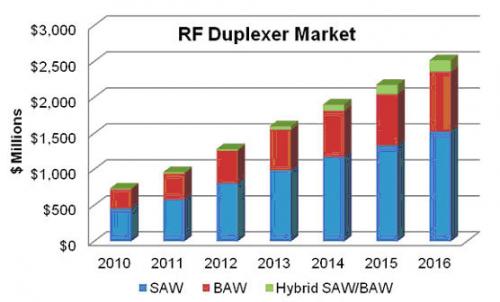TriQuint Semiconductor's new high-performance sonic filter, a leader in RF solutions for technological innovation, has been adopted by the popular 4G smartphones such as Samsung, LG, HTC and Motorola Mobility. These new filters, now in volume shipments, use TriQuint's extensive technology portfolio to deliver the outstanding filtering performance required for the most challenging LTE bands.
LTE deployments are driving the need for high performance filters in today's multi-band smartphones. High-end smartphones have more and more cellular and Wi-Fi bands to support 2G/3G/4G voice and data services and global roaming. In addition, the global shortage of spectrum resources has led governments around the world to squeeze into new frequency bands for 4G wireless services in the vicinity of existing frequency bands, with minimal protection bands. Advanced filtering techniques are therefore needed to mitigate the resulting interference problems.
“Our customers rely on TriQuint to solve their toughest filtering challenges,†said Xiong Ting, general manager of TriQuint Semiconductor China. “Thanks to 30 years of filtering technology innovation and our extensive manufacturing expertise, we are already in sonic technology. Significant progress has been made in the field. We are one of the very few high-volume suppliers to meet the demanding performance requirements of the most stringent LTE filter bands. In the next few years, the deployment of the next-generation LTE Advanced upgrade network will further drive More TriQuint high-performance filter requirements to get the benefits of carrier aggregation."
Filters, duplexers and switching products have accounted for nearly half of the total $64 billion RF market. As LTE networks continue to deploy, passive devices in smartphones, tablets and other mobile devices will continue to grow. “With our technology leadership, unparalleled integration expertise, chipset reference design and ongoing capacity investment, TriQuint is well positioned to win more business in this important market segment,†said Xiong Ting. TriQuint added 40% of its manufacturing capacity in 2011 to support customers' demand for their growing portfolio of mobile devices.
Explosive demand for smartphone filters

Driven by the growth of WCDMA and the deployment of LTE networks, the market for RF duplexers for cellular terminals will reach $2.5 billion in 2016. (Information: Navian Inc.)
"The RF duplexer market alone will reach $2.5 billion in 2016," said Yoshiyasu Andoh, president ofNavian Market Research. "The widespread use of WCDMA and the growing LTE band are driving the duplexer at a rapid rate. Product requirements. As the complexity of RF increases, we are expected to see passive components such as filters and duplexers, and further integration with active components such as power amplifiers and switches.
High performance 4G filtering
With the deployment of LTE networks and the popularity of Wi-Fi, the demand for high-performance filters has proliferated. The new 4G band is usually in close proximity to the existing band for Wi-Fi and Bluetooth services, and the guard band is very small. TriQuint's Body Sound Wave (BAW) and Temperature Compensation (TC-SAW) technologies help 4G smartphones running in many different frequency bands in multiple regions of the world, while enabling voice and data services. Since 2006, TriQuint's SAW filters have shipped more than 2 billion, and BAW filters have shipped close to $1 billion.
In addition to mobile devices, TriQuint's innovations in SAW, TC-SAW and BAW devices have become the foundation of the world's most advanced communications systems through research and development partnerships with partners such as the Defense Advanced Research Projects Agency (DARPA). TriQuint is the only high-volume RF supplier to offer all three filters, either as stand-alone devices or as integrated modules. By integrating active and passive components into the micromodules, TriQuint uses innovative technologies such as CuFlip and its new Wafer Level Package (WLP) process to provide size, cost and performance advantages.
TC-SAW and BAW: Support 4G smartphones
The SAW filter is well suited for most frequencies up to 1.9 GHz, such as the standard GSM, CDMA and 3G bands. Some new 3G and 4G WCDMA duplexers and filters are most beneficial to TC-SAW, reducing temperature drift for more challenging specifications. For example, TriQuint uses TC-SAW to support duplexers for Band 13, Band 20, and Band 26.
BAW is ideal for many new LTE bands above 1.9 GHz, offering excellent performance with lower insertion loss, steeper ramps and superior rejection. BAW excels in applications where the uplink and downlink frequency spacing is minimal and when attenuation is required in tightly packed adjacent frequency bands. TriQuint leverages the advantages of BAW technology to support the following frequency bands: Band 3, Band 7, Band 25, Band 38, Band 40, Band 41, and Wi-Fi coexistence filters.
48V20Ah Lithium Ion Battery,48V 20Ah Lithium Iron Electric Bicycle Battery,48V20Ah Electrict Scooter Battery,Lifepo4 Lithium Battery 48V20A
Jiangsu Zhitai New Energy Technology Co.,Ltd , https://www.ztbatteries.com